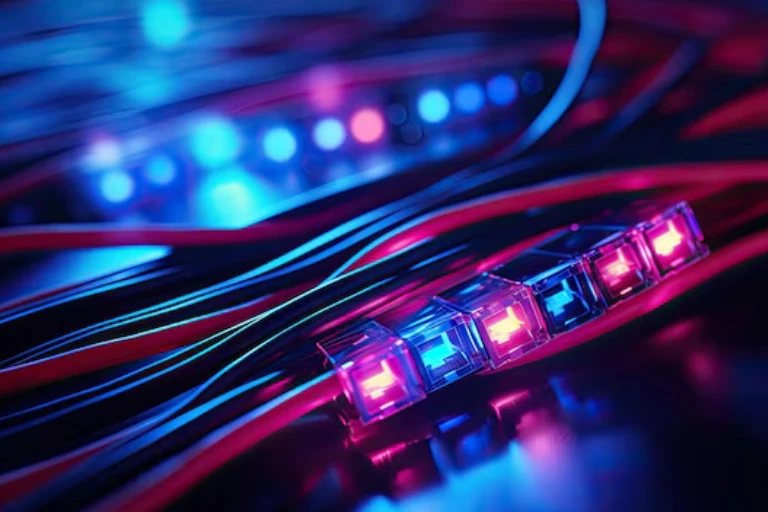In today’s hyper-connected world, where high-speed internet is the backbone of everything from streaming to remote work, fiber optics stands tall as the gold standard for connectivity. With its incredible speed, unmatched reliability, and ability to support our ever-growing digital demands, fiber-optic technology is revolutionizing the way we connect to the internet and communicate with each other.
In this blog, we’ll delve into the fascinating world of fiber optics—exploring its technology, benefits, applications, and why it’s the future of connectivity. Whether you’re a tech enthusiast or a business owner considering an upgrade, this is your ultimate guide to fiber optics.
What Are Fiber Optics?
Fiber optics refers to a technology that uses thin strands of glass or plastic, known as optical fibers, to transmit data as light signals. Unlike traditional copper cables, which use electrical signals, fiber-optic cables harness the speed of light to transfer information. This enables incredible data transmission rates over long distances with minimal loss of quality.
How Fiber Optics Works
Fiber-optic cables are composed of three main parts:
- Core: The innermost layer, where light signals travel.
- Cladding: A reflective layer surrounding the core, ensuring light signals stay within the core.
- Coating: A protective outer layer that shields the cable from physical damage and environmental factors.
Data is transmitted by converting digital information into light pulses, which travel through the core at nearly the speed of light. The cladding reflects the light, keeping it contained and ensuring a smooth journey to its destination. At the receiving end, the light pulses are converted back into digital data, ready for use.
The Unmatched Benefits of Fiber Optics
- Blazing-Fast Speeds Fiber optics offers lightning-fast internet speeds, reaching up to 1 Gbps and beyond. This is ideal for bandwidth-heavy activities like 4K streaming, online gaming, and video conferencing without buffering.
- Incredible Reliability Unlike copper cables, fiber-optic networks are immune to electromagnetic interference, weather conditions, and signal degradation. This ensures consistent and dependable connectivity.
- Future-Proof Technology With growing demands for higher speeds and more connected devices, fiber optics is designed to handle it all. It’s a future-ready solution that can adapt to advancements like 5G, IoT, and AI-driven applications.
- Extended Range Fiber-optic cables can transmit data over long distances without compromising performance, making them ideal for sprawling urban networks and rural connectivity projects.
- Enhanced Security The design of fiber-optic cables makes them difficult to tap into, providing a more secure connection compared to traditional methods. This makes fiber optics a top choice for businesses handling sensitive data.
- Eco-Friendly Connectivity Fiber-optic networks consume less energy compared to copper-based systems, contributing to a greener, more sustainable future.
Key Applications of Fiber Optics
- Residential Internet From streaming your favorite shows to running a smart home, fiber optics ensures fast, seamless connectivity for households.
- Businesses and Enterprises Reliable, high-speed internet is essential for modern businesses. Fiber optics supports cloud computing, video conferencing, and large-scale data transfers effortlessly.
- Telecommunications Telecom providers rely on fiber-optic technology to deliver high-speed internet and reliable phone services to millions of users worldwide.
- Healthcare Fiber optics powers telemedicine, real-time imaging, and secure electronic medical records, transforming the healthcare industry.
- Smart Cities As cities become smarter, fiber optics provides the infrastructure for IoT devices, traffic management systems, and public safety networks.
- Education From virtual classrooms to research institutions, fiber-optic networks enable uninterrupted access to educational resources.
Why Fiber Optics is the Future of Connectivity
As the world moves toward faster, more reliable internet, fiber optics is emerging as the cornerstone of next-generation networks. Here’s why:
- 5G Integration Fiber optics forms the backbone of 5G networks, enabling ultra-fast wireless connectivity and supporting innovations like autonomous vehicles and smart cities.
- IoT Revolution With billions of devices connecting to the internet, fiber optics ensures low-latency, high-bandwidth support for IoT ecosystems.
- Streaming and Cloud Services From Netflix to cloud gaming, fiber optics meets the growing demand for high-quality streaming and seamless cloud experiences.
- Global Digital Transformation Governments and private companies are investing heavily in fiber-optic infrastructure to bridge the digital divide and empower communities worldwide.
Make the Switch to Fiber Optics Today
Whether you’re a homeowner seeking better connectivity or a business aiming for growth, fiber optics offers a reliable, high-performance solution. By investing in fiber-optic technology, you’re not just upgrading your internet—you’re preparing for a future where seamless, high-speed connectivity is a necessity.
Don’t get left behind in the digital revolution. Make the switch to fiber optics today and experience the difference in speed, reliability, and performance. The future is here, and it’s powered by light.

